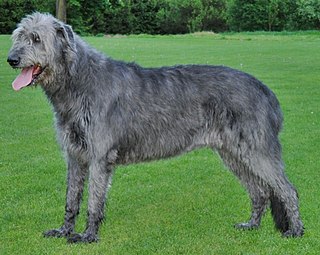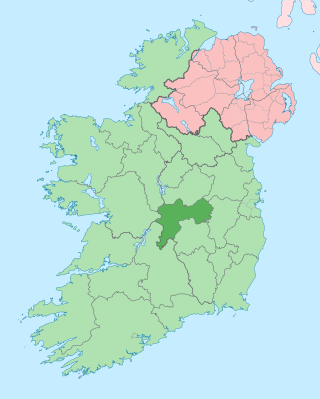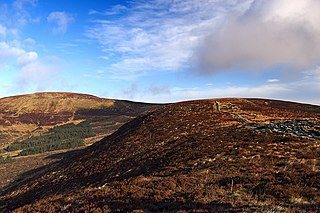
The Irish Wolfhound is a breed of large sighthound that has, by its presence and substantial size, inspired literature, poetry and mythology. One of the largest of all breeds of dog, the breed is used by coursing hunters who have prized it for its ability to dispatch game caught by other, swifter sighthounds. In 1902, the Irish Wolfhound was declared the regimental mascot of the Irish Guards.

Lugh or Lug is a figure in Irish mythology. A member of the Tuatha Dé Danann, a group of supernatural beings, Lugh is portrayed as a warrior, a king, a master craftsman and a saviour. He is associated with skill and mastery in multiple disciplines, including the arts. Lugh also has associations with oaths, truth and the law, and therefore with rightful kingship. Lugh is linked with the harvest festival of Lughnasadh, which bears his name. His most common epithets are Lámfada and Samildánach. This has sometimes been anglicised as "Lew of the Long Hand".
In Irish mythology, Dian Cécht was the god of healing, the healer for the Tuatha Dé Danann, and son of the Dagda according to the Dindsenchas.
Tailtiu or Tailltiu is the name of a presumed goddess from Irish mythology. The goddess's name is linked to Teltown in Co. Meath, site of the Óenach Tailten. A legendary dindsenchas "lore of places" poem relates a myth connecting the presumed goddess Tailtiu with the site. However, linguistic analysis of the name reveals that Tailtiu as a place-name derives from a loan word of Brythonic origin represented by the Welsh telediw "well formed, beautiful." The mythological character of Tailtiu likely derives her name from the place-name.
Magh Slécht is the name of a historic plain in Ireland. It comprises an area of about three square miles (8 km2) situated in the south-eastern part of the Parish of Templeport, Barony of Tullyhaw, in the west of County Cavan. It is bounded on the south by Templeport Lough, on the north by Slieve Rushen mountain, on the east by the Shannon–Erne Waterway, and on the west by the River Blackwater. Magh Slécht formed part of the Province of Connacht until the late 16th century, when it was made part of the Province of Ulster by the English Crown.

Rosenallis is a village in north County Laois, Ireland. It is in the foothills of the Slieve Bloom Mountains on the R422 Mountmellick to Birr road, 6 km north-west of Mountmellick. The village is in a townland and civil parish of the same name.

County Offaly is a county in Ireland. It is part of the Eastern and Midland Region and the province of Leinster. It is named after the ancient Kingdom of Uí Failghe. It was formerly known as King's County, in honour of Philip II of Spain. Offaly County Council is the local authority for the county. The county population was 82,668 at the 2022 census.

Breogán is a character in the Lebor Gabála Érenn, a medieval Christian history of Ireland and the Irish. He is supposedly the son of Brath, and is described as an ancestor of the Gaels. The Lebor Gabála purports to be an account of how the Gaels descend from Adam through the sons of Noah and how they came to Ireland.
Cairbre Nia Fer, son of Rus Ruad, was, according to medieval Irish legend and historical tradition, a King of Tara from the Laigin.
Lugaid Riab nDerg or Réoderg, son of the three findemna, triplet sons of Eochu Feidlech, and their sister Clothru was, according to medieval Irish legend and historical tradition, a High King of Ireland.

Kinnitty is a village in County Offaly, Ireland. It is located 13 km east of Birr on the R440 and R421 regional roads. The village is in a civil parish of the same name.

The Ballyhoura Mountains are in south-east County Limerick and north-east County Cork in central Munster, Ireland, running east and west for about 6 miles on the borders of both counties.
Niall Ó Dónaill was an Irish language lexicographer from Ailt an Eidhinn, Loughanure, County Donegal. He was the oldest of the six children of Tarlach Ó Dónaill and Éilis Nic Ruairí from Grial, Loughanure. They had a little land and a few cows. His father would spend June to November working in Scotland and died when Niall Ó Dónaill was 13 years old. Ó Dónaill himself would spend summers working in the tunnels in Scotland.

Djouce at 725 metres (2,379 ft), is the 74th–highest peak in Ireland on the Arderin scale, and the 91st–highest peak on the Vandeleur-Lynam scale. Djouce is situated in the northeastern section of the Wicklow Mountains, and dominates the views of the Wicklow Mountains from Roundwood to Newtownmountkennedy. Djouce is one of a few Irish mountains for which the Irish Office of Public Works (OPW) maintain a boarded mountain trail, using railway sleepers, from its base to a point close to its summit; making the mountain even more accessible to the public, but while also protecting the underlying bog and soil from human erosion. Djouce is popular with hill walkers, and it lies along the 131-kilometre Wicklow Way; on its southern slopes at a scenic viewpoint is the J.B. Malone memorial stone, dedicated to the creator of the Wicklow Way.

Kinnitty Castle or Castle Bernard is a 19th-century gothic revival castle and hotel in Kinnitty, County Offaly, Ireland. It is located contiguous to Droughtville and Lettybrook, north of the Slieve Bloom Mountains on the R421 regional road between the villages of Kinnitty and Cadamstown. A nearby pyramid was built by the Bernard family who resided in the castle.
Mór Muman or Mór Mumain is a figure from early Irish literature who is said to have been a queen of Munster and daughter of king Áed Bennán. Her name means "the Great Mother" and the province of Munster is named after her. She is believed to be a euhemerised mother goddess and sovereignty goddess of the province, particularly of the Eóganachta. Mór Muman "personifies the land of Munster" and "the sovereignty of the region". She is also known as Mugain and may be the same figure as Anu and the Morrígan.

Caherconree at 835 metres (2,740 ft), is the 20th–highest peak in Ireland on the Arderin scale, and the 27th–highest peak on the Vandeleur-Lynam scale. Caherconree is the 2nd-highest mountain in the Slieve Mish Mountains in the Dingle Peninsula in County Kerry, Ireland, and one of its southerly spurs is the site of an ancient stone promontory fort, which is a protected National Monument.
"Say 'uncle'!" is a chiefly North American expression demanding that the opponent in a contest submit. The response "Uncle!" is equivalent to "Mercy!", "Please!", "I give up!" or similar sentiment, and indicates submission.

The Slieve Bloom Way is a long-distance trail around the Slieve Bloom Mountains in Ireland. It is a 70-kilometre (43-mile) long circular route that can be accessed from any of the trailheads at Glenbarrow near the village of Rosenallis, County Laois.Cadamstown, County Offaly Kinnitty, County Offaly. It is typically completed in three days. It is designated as a National Waymarked Trail by the National Trails Office of the Irish Sports Council and is managed by Laois County Council, Offaly County Council, Laois Integrated Development Company, Coillte and the Slieve Bloom Rural Development Society. The route was devised by a local man, Tom Joyce, and opened in 1987. The route was developed as part of the designation of the Slieve Bloom area as a European Environment Park in the European Year of the Environment.













